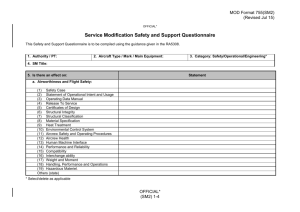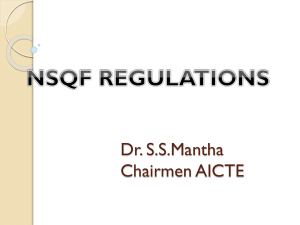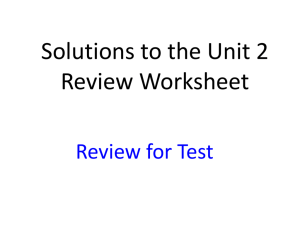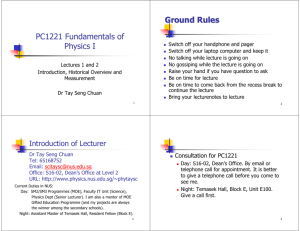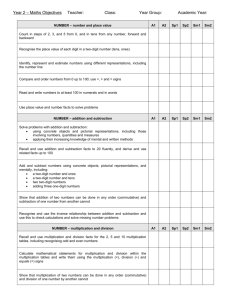On Two Measures of Problem Instance
advertisement
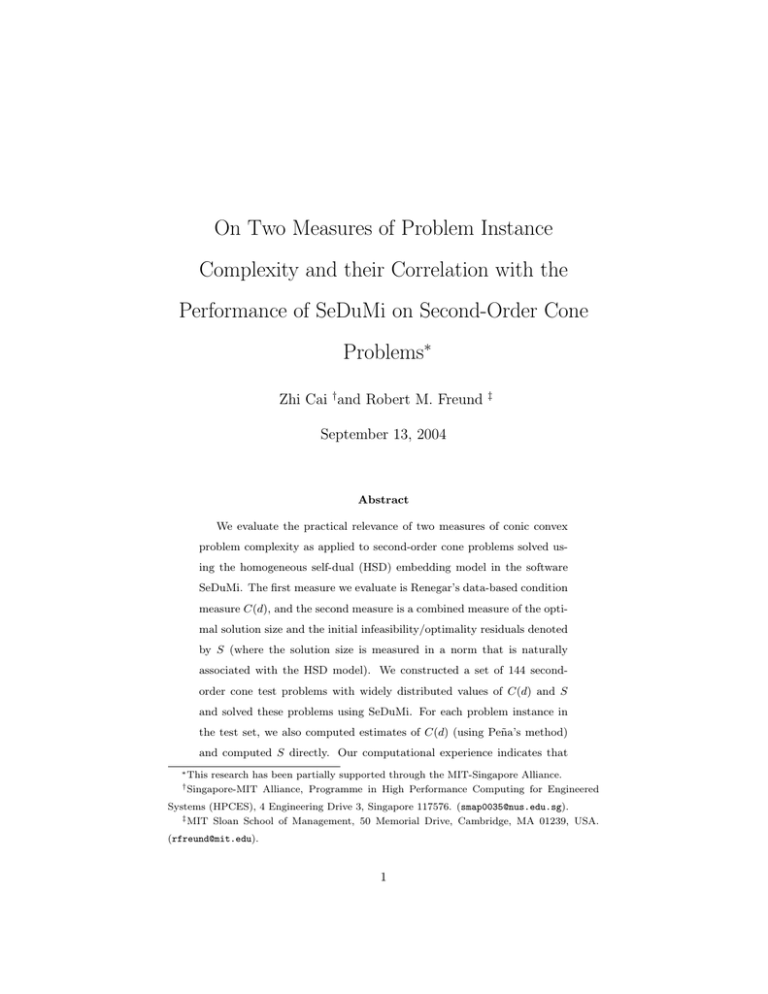
On Two Measures of Problem Instance
Complexity and their Correlation with the
Performance of SeDuMi on Second-Order Cone
Problems∗
Zhi Cai †and Robert M. Freund
‡
September 13, 2004
Abstract
We evaluate the practical relevance of two measures of conic convex
problem complexity as applied to second-order cone problems solved using the homogeneous self-dual (HSD) embedding model in the software
SeDuMi. The first measure we evaluate is Renegar’s data-based condition
measure C(d), and the second measure is a combined measure of the optimal solution size and the initial infeasibility/optimality residuals denoted
by S (where the solution size is measured in a norm that is naturally
associated with the HSD model). We constructed a set of 144 secondorder cone test problems with widely distributed values of C(d) and S
and solved these problems using SeDuMi. For each problem instance in
the test set, we also computed estimates of C(d) (using Peña’s method)
and computed S directly. Our computational experience indicates that
∗ This
research has been partially supported through the MIT-Singapore Alliance.
Alliance, Programme in High Performance Computing for Engineered
† Singapore-MIT
Systems (HPCES), 4 Engineering Drive 3, Singapore 117576. (smap0035@nus.edu.sg).
‡ MIT Sloan School of Management, 50 Memorial Drive, Cambridge, MA 01239, USA.
(rfreund@mit.edu).
1
SeDuMi iteration counts and log(C(d)) are fairly highly correlated (sample correlation R = 0.676), whereas SeDuMi iteration counts are not quite
as highly correlated with S (R = 0.600). Furthermore, the experimental
evidence indicates that the average rate of convergence of SeDuMi iterations is affected by the condition number C(d) of the problem instance, a
phenomenon that makes some intuitive sense yet is not directly implied
by existing theory.
1
Introduction
The homogeneous self-dual (HSD) embedding model for linear optimization was
originally developed by Ye, Todd, and Mizuno in [14], and has been extended
to the conic case and implemented in software such as SeDuMi [13]. The HSD
model has the very desirable property that it always has a strictly feasible
primal/dual solution regardless of the feasibility of the original problem. Using
a natural norm associated with the HSD model’s starting point, the norms of
approximately optimal solutions and their distances from the boundaries of the
underlying cones are precisely controlled independent of the problem instance,
see [5]. Furthermore, a reinterpretation of a standard stopping criterion for
HSD interior-point methods shows that the performance of these methods is
inherently related to the sizes of optimal solutions and the sizes of the initial
infeasibilities, also see [5].
In this paper we evaluate the relevance of two measures of conic convex
problem complexity as applied to second-order cone problems solved using the
homogeneous self-dual (HSD) embedding model in the software SeDuMi. The
first measure we evaluate is Renegar’s data-based condition measure C(d), and
the second measure is a combined measure of the optimal solution size and the
initial infeasibility/optimality residuals denoted by S (where the solution size is
measured in a norm that is naturally associated with the HSD model).
2
Consider the primal-dual conic linear system:
(Pc ) minx {cT x | Ax = b, x ∈ CX }
∗
(Dc ) maxy,z {bT y | AT y + z = c, z ∈ CX
}
(1)
∗
where CX is a closed convex cone and CX
is the corresponding dual cone.
The complexity of computing approximately optimal solutions of (Pc ) has been
developed along two related approaches. The first approach is via the data-based
condition measure theory of Renegar [1, 2, 9, 10, 11, 12]. The problem data d
is the triplet d = (A, b, c). The “distance to infeasibility” ρ(d) is the minimum
data perturbation ∆d that renders either the perturbed primal (Pc ) or dual
(Dc ) infeasible. The condition measure C(d) is defined to be the ratio d/ρ(d).
This condition measure play a key role in the complexity analysis of (Pc ) in [12].
In theory, the number of iterations of a suitably designed interior-point method
(IPM) algorithm (but not the HSD model) needed to approximately solve (Pc )
√
is bounded by O( ϑ log(C(d) + . . .)), see [12], where ϑ is the self-concordance
parameter of the barrier function used for the cone CX . Two efficient methods
for estimating C(d) have been developed, see Peña [8] and [3], [7].
The second approach to developing a complexity theory for (Pc ) is via geometric measures of the problem, using quantities such as the norm of the largest
-optimal primal and dual solutions. Let RP denote the norm of the largest optimal solution of (Pc ), with RD defined analogously for the dual cone variables
z, and let R := RP +RD . These quantities appear in the complexity analysis of
(Pc ) in [4] as well as in [5]. In theory, with a choice of norm naturally connected
to the starting point of the HSD model, the number of iterations of a suitably
designed interior-point method (IPM) needed to approximately solve (Pc ) via
√
the HSD model is bounded by O( ϑ log(R +. . .)), see [5]. If the norm is chosen
judiciously, then R can be computed efficiently.
The explanatory value of C(d) for non-HSD IPM algorithms was first explored in [7], which examined the relationship between the condition measure
C(d) and the IPM iterations of the CPLEX barrier software (a commercial IPM
solver) on linear programming problems from the NETLIB suite. It was ob-
3
served that 42% of the variation in the IPM iteration counts among the NETLIB
suite problems is accounted for by log(C(d)). The analysis in [7] was limited to
linear programming instances, whose performance with interior-point methods
tends to be different from more general conic linear systems.
In this paper, we explore the relationship between the condition measure
C(d) and the combined solution size and initial infeasibility measure S, and
the number of iterations needed to approximately solve an SOCP problem using the HSD embedding in the IPM code SeDuMi. We constructed a set of
144 second-order cone test problems with widely distributed values of C(d)
and S and solved these problems using SeDuMi. For each problem instance in
the test set, we also computed estimates of C(d) (using Peña’s method) and
computed S directly. Our computational experience indicates that SeDuMi iteration counts and log(C(d)) are fairly highly correlated (sample correlation
R = 0.676), whereas SeDuMi iteration counts are not quite as highly correlated
with S (R = 0.600). Furthermore, the experimental evidence indicates that the
average rate of convergence of SeDuMi iterations is affected by the condition
number C(d) of the problem instance, a phenomenon that makes some intuitive
sense yet is not directly implied by existing theory.
The paper is organized as following: Section 2 presents the notation for the
standard form second-order cone optimization problem and the homogeneous
self-dual embedding model. Section 3 describes the details of computing the
condition measure C(d) of a problem instance using Peña’s method. Section
4 contains the method for creating the test problems and the computational
evaluation of the correlation between C(d) and SeDuMi iterations. Section 5
presents the combined measure of optimal solution size and initial infeasibility
gap denoted by S, and the computational evaluation of the correlation between
S and SeDuMi iterations. Section 6 contains brief concluding remarks.
Acknowledgement. We are grateful to Kim Chuan Toh for computational
advice and for reading and editing an earlier draft of this paper.
4
2
Preliminaries
This section defines a standard SOCP problem, followed by a brief review of
the homogeneous self-dual embedding model that is used in SeDuMi.
2.1
SOCP in standard form
The standard second-order cone in IRk is defined to be
k
KSOC
:= {v = (v 0 , v̄) ∈ IR × IRk−1 : v̄2 ≤ v 0 } ,
k
and we write “v 0” if v ∈ KSOC
. The standard form SOCP primal and dual
problems are:
(P) v ∗ :=
min
s.t.
Al xl + Aq xq = b
(cl )T xl + (cq )T xq
xli ≥ 0,
i = 1, . . . , N l ,
(D) w∗ :=
max
s.t.
(Al )T y + z l = cl ,
xqi 0,
i = 1, . . . , N q
(2)
bT y
(Aq )T y + z q = cq ,
zil ≥ 0,
i = 1, . . . , N l ,
ziq 0,
i = 1, . . . , N q
where y ∈ Rm and the superscript “l” indicates the linear variables and
the coefficients related to the linear variables: xl = [xl1 ; . . . ; xlN l ], N l is the
l
l
number of linear variables, and Al ∈ Rm×N and cl ∈ RN are the matrices and
objective function vectors associated with the linear variables. Similarly, the
superscript “q” indicates the second-order cone variables and the coefficients
related to the second-order cone variables: N q is the number of second-order
cones, and nqi is the dimension of the ith second-order cone and we write xqi ∈
q
Rni , i = 1, . . . , N q and xq = [xq1 ; . . . ; xqN q ]. The total number of second-order
N q
cone variables is denoted as nq = i=1 nqi . The matrices and objective function
q
vectors associated with the second-order cone variables are Aq ∈ Rm×n , cq ∈
q
Rn . Analogous notation is used for the dual problem.
5
Let N = N l + N q , A = [Al Aq ], c = [cl ; cq ], x = [xl ; xq ] and z = [z l ; z q ].
x 0 (x 0) means that all xli and xqi are in (the interior of) their defined
cones. We also define, for xqi , ziq 0,
γ(xqi ) =
γ(ziq ) =
(x0i )2 − x̄i 22 ,
(zi0 )2 − z̄i 22 .
(3)
The self-concordant barrier function associated with (P) is
f (x) := −
Nl
ln(xli ) −
i=1
Nq
ln(γ 2 (xqi ))
i=1
whose complexity value ϑ is:
ϑ = N l + 2N q ,
(4)
see [6].
2.2
The Homogeneous Self-Dual Embedding Model
IPM solvers that apply the homogeneous self-dual embedding model embed the
primal and dual problems into the self-dual optimization problem:
(HSD) : minx,y,z,τ,κ,θ
ᾱθ
−Ax
s.t.
AT y
−bT y
+cT x
b̄T y
+c̄T x
+bτ
−b̄θ
−cτ
−c̄θ
=
0
=
0
+κ =
0
=
ᾱ
+z
−ḡθ
+ḡτ
x0 τ ≥0
z0
κ≥0.
(5)
Let (x(0) , y (0) , z (0) , τ (0) , κ(0) , θ(0) ) satisfy x(0) 0, z (0) 0, τ (0) > 0, κ(0) > 0,
and θ(0) > 0, and let b̄, c̄, ḡ, ᾱ be defined as follows:
bτ (0) − Ax(0)
;
θ(0)
cT x(0) − bT y (0) + κ(0)
;
ḡ =
θ(0)
b̄ =
AT y (0) + z (0) − cτ (0)
;
θ(0)
(x(0) )T z (0) + τ (0) κ(0)
ᾱ =
.
θ(0)
c̄ =
6
If the original problem is primal and dual feasible, (HSD) has an optimal
solution (x∗ , y ∗ , z ∗ , τ ∗ , κ∗ , θ∗ ) satisfying θ∗ = 0 and τ ∗ > 0. In this case x∗ /τ ∗
and (y ∗ /τ ∗ , z ∗ /τ ∗ ) will be optimal solutions to the original problems (P) and
(D), respectively.
Let (x, y, z, τ , κ, θ) be a feasible solution of HSD satisfying τ > 0. Then
the current test solutions for (P) and (D) are given by x̄ := x/τ and (ȳ, z̄) :=
(y/τ, z/τ ), respectively. HSD IPM solvers, including SeDuMi, compute iterates
until the primal and dual infeasibility and duality gaps of the current iterates’
test solution are small. These are given by:
rp = b − Ax̄
(primal infeasibility gap)
rd = AT ȳ + z̄ − c
(dual infeasibility gap)
rg = c x̄ − b ȳ
(duality gap)
T
T
(6)
For example, SeDuMi uses the following criterion for terminating the algorithm:
2
rd ∞
(rg )+
rp ∞
≤ rmax ,
+2
+
T
1 + b∞
1 + c∞
max(|c x|, |bT y|, 0.001 × τ )
(7)
where rmax = 10−9 is the default value.
3
Computing the Condition Measure of an SOCP
Problem Instance Using Peña’s Method
Consider the primal feasibility conditions associated with (1):
Ax = b ,
x ∈ CX .
(8)
The data for (1) is d = (A, b, c), the data for the primal feasibility problem is
dP = (A, b), and consider the norm on dP the data given by
dP := [A, −b]2 := max{Ax − bt : x2 + t2 ≤ 1} ,
where the Euclidean norm is used for all vectors in the above expression. Let
IP := {(A, b) : the system (8) is infeasible} .
7
The distance to primal infeasibility ρP (d) is defined to be the norm of the
smallest data perturbation ∆dP = (∆A, ∆b) that renders the resulting primal
system infeasible:
ρP (dP ) := inf{[∆A, ∆b]2 : (A + ∆A, b + ∆b) ∈ IP } .
We consider the dual problem in a similar way. The dual conic system is:
∗
z ∈ CX
.
AT y + z = c ,
(9)
The data for this system is dD = (A, c), and consider the norm on the data
given by
dD := [A, −c]2 := max{AT y − ct : y2 + t2 ≤ 1} .
Let
ID := {(A, c) : the system (9) is infeasible} .
The distance to dual infeasibility ρD (d) is defined to be the norm of the smallest
data perturbation ∆dD = (∆A, ∆c) that renders the resulting dual system
infeasible:
ρD (dD ) := inf{[∆A, ∆c]2 : (A + ∆A, c + ∆c) ∈ ID } .
Since the primal (dual) distance to infeasibility is independent of the data c (b),
we write ρP (d) := ρP (dP ) and ρD (d) := ρD (dD ). The condition measure C(d)
of the primal/dual system is the ratio:
C(d) =
d
,
min{ρP (d), ρD (d)}
where ρP (d) and ρD (d) are the primal and dual distances to infeasibility, respectively, d = (A, b, c) is the data for the primal and dual problems, and d
is defined as:
d = max {dP , dD } .
(10)
We remark that C(d) is connected to a wide variety of behavioral, geometric,
and algorithmic complexity bounds on the problems (P) and (D), see [11, 12, 1,
2, 3, 8, 9, 10], for example.
8
Computing C(d) involves computing the four quantities dP , dD , ρP (d),
ρD (d). Notice that the first two quantities are maximum eigenvalue computa
tions, for example, dP = [A, −b]2 = λmax ([A, −b][A, −b]T ), and so pose
little computational burden. However, the primal and dual distances to infeasibility ρP (d), ρD (d) are not as straightforward to compute. Peña [8] presents an
efficient method for computing lower and upper bounds on the primal and/or
dual distance to infeasibility that involves the solution of six convex optimization problems each of whose computational cost is similar to that of the original
primal and/or dual problems. The computational details of Peña’s method are
summarized in the following subsections. For a theoretical justification of the
method, see [8].
3.1
Estimating the distance to infeasibility ρP (d) of the
primal problem
In Peña’s method, the estimation of the distance to infeasibility ρP (d) involves
the following steps.
Step 1: Compute the analytic center (x∗ , t∗ ) of the homogenized primal feasible
region by solving the following problem:
N q N l
f (x, t) := − ln 1 − t2 − x22 − ln(t) − i=1 ln xli − i=1 ln γ 2 (xqi )
(P1)
minx,t
s.t.
Ax − bt = 0,
(11)
x 0,
t>0.
Step 2: Compute the minimum eigenvalue λP and its corresponding unit eigenvector VP of the matrix MP = [A, −b]H(x∗ , t∗ )−1 [A, −b]T , where H(x, t) is the
Hessian of f (x, t).
P
Step 3: Compute optimal solutions (xP
± , t± ) of the following two problems:
P
:=
(P2) δ±
min
s.t.
Ax − bt = ±VP ,
δ
x 0, t ≥ 0,
t2 + x22 ≤ δ .
9
(12)
Step 4: Compute lower and upper bound for ρP (d) and the associated perturbation to infeasibility:
1 1 LP (d) =: λP ≤ ρP (d) ≤ min
,
, ϑ λP := UP (d).
P δP
δ+
−
⎧ 2
⎪
1
T
P
⎪
(−VP (xP
⎪
P
+ ) , VP t+ )
⎪
⎨ δ+
(∆AP , ∆bP ) :=
⎪
⎪
⎪
⎪
⎩
1
P
δ−
2
(13)
P
P
if δ+
> δ−
(14)
T
P
(VP (xP
− ) , −VP t− )
P
P
if δ+
≤ δ−
.
According to Propositions 3.1 and 4.1 of [9], and by using some intermediary
results of Peña’s method, it follows that (A + (1 + )∆AP , b + (1 + )∆bP ) ∈ IP
for all > 0.
3.2
Estimating the distance to infeasibility ρD (d) of the
dual problem
The estimation of the distance to infeasibility ρD (d) is quite similar to that for
ρP (d), and involves the following steps.
Step 1: Compute the analytic center (y∗ , p∗ , z∗ ) of the homogenized dual feasible region by solving the following problem:
N q N l
(D1)
miny,p,z − ln 1 − p2 − y22 − ln(p) − i=1 ln zil − i=1 ln γ 2 (ziq )
(15)
s.t.
A y + z − cp = 0,
T
z 0,
p > 0.
Step 2: Compute the minimum eigenvalue λD and its corresponding unit eigenvector VD of the matrix MD = [AT , −c]H(y∗ , p∗ )−1 [AT , −c]T + H(z∗ ), where
H(y, p) is the Hessian of the function f (y, p) = − ln(1 − y22 − p2 ) − ln(p) and
N q N l
H(z) is the Hessian of the function f (z) = − i=1 ln zil − i=1 ln γ 2 (ziq ) .
P
P
Step 3: Compute optimal solutions y±
, pP
± , z± of the following two problems:
D
:=
(P2) δ±
min
s.t.
AT y + z − cp = ±VD ,
δ
z 0, p ≥ 0,
p2 + y22 ≤ δ .
10
(16)
Step 4: Compute lower and upper bound for ρD (d) and the associated perturbation to infeasibility:
LD (d) =:
λD ≤ ρD (d) ≤ min
1 1
,
,
ϑ
λD
D δD
δ+
−
⎧ 2
⎪
1
D
⎪
(−y+
(VD )T , VD pD
⎪
D
+)
⎪
⎨ δ+
(∆AD , ∆cD ) :=
⎪
⎪
⎪
⎪
⎩
1
D
δ−
2
:= UD (d).
(17)
D
D
if δ+
> δ−
(18)
D
(y−
(VD )T , −VD pD
−)
D
D
if δ+
≤ δ−
.
As in the case of the primal distance to infeasibility, it follows that (A + (1 +
)∆AD , c + (1 + )∆cD ) ∈ ID for all > 0.
3.3
Estimating the Condition Measure and Computing
the Associated Perturbation to Infeasibility
Once the bounds on ρP (d) and ρD (d) have been computed, lower and upper
bounds for C(d) are computed as follows:
CL (d) :=
d
d
≤ C(d) ≤
= CU (d). (19)
min {UP (d), UD (d)}
min {LP (d), LD (d)}
Finally, the associated perturbation associated with the above estimation
procedure is:
⎧
⎪
⎪
(∆AP , ∆bP , 0)
⎪
⎨
(∆A, ∆b, ∆c) :=
⎪
⎪
⎪
⎩ (∆A , 0, ∆c )
D
D
if UP (d) < UD (d)
(20)
if UP (d) ≥ UD (d) .
Using this perturbation, it is straightforward to show that
min{ρP (d+α∆d), ρD (d+α∆d)} ≤ (1−α) min{UP (d), UD (d)} for all α ∈ [0, 1] .
(21)
11
4
Test Problems, Condition Measures, and Correlation with SeDuMi Iterations
We created 144 SOCP test problem instances with widely varying condition
measures C(d) as follows. We first created 12 random SOCP instances whose
dimensions are described in Table 1. For each problem instance d = (A, b, c) in
this group of 12, we computed the condition measure C(d) and the associated
perturbation to infeasibility ∆d := (∆A, ∆b, ∆c) using Peña’s method as described in Section 3. We then used this perturbation to create 11 increasingly
ill-conditioned instances of the form (A, b, c)+α(∆A, ∆b, ∆c) for the 11 different
values of α ∈ (0, 1), namely α = 0.1, 0.5, 0.75, 0.9, 0.95, 0.97, 0.99, 0.995, 0.999,
0.9995, and 0.9999. Note from (21) that the distance to infeasibility of these 11
new instances will approach 0 as α approaches 1, thereby generating problems
that are increasingly ill-conditioned. We applied this procedure to each of the 12
random SOCP problem instances, thus creating a total of 144 SOCP problems
with widely varying condition measures. These problems were named according
to their original instance from the first column of Table 1 and the value of α
that was used to create the perturbed problem instance; for example problem
instance sm 18 999 was created by perturbing problem instance sm 18 by its
associated perturbation to infeasibility using α = 0.999.
We computed the estimates of the condition measure C(d) for each of the
144 problem instances using Peña’s method. Table 2 shows the computed lower
and upper bounds CL and CU , respectively, as well as the logarithm of their
√
geometric mean C̄ = CL CU . (all logarithm values are base 10). Notice that
C̄ ranges from 102 to 109 . Also notice in general that in each problem group
both CL and CU grow inversely proportional to (1 − α), where α is the extent of perturbation in (21). For example, CL and CU for “sm 18 9995” are
approximately 2 times larger than the values for “sm 18 999” and are 10 times
larger than the values for “sm 18 995”. For those problems with CU close to
109 , the minimum eigenvalues of the associated matrices are in the range 10−15
12
Table 1: Problem dimensions of 12 randomly generated SOCP problem instances. In the column “SOC Dimensions”, “8×3” means 8 cones of dimension
3, for example.
Problem
Rows
Variables
Nonnegative
Second-Order
SOC
Instance
(m)
(n)
Variables
Cones
Dimensions
54
913
411
69
sm 18
[8×3, 7×4, 5×5, 7×6, 7×7
8×8 11×9 8×10, 5×11, 3×12]
sm 19
55
228
57
42
[15×3, 13×4, 10×5, 4×6]
sm2 3
2
54
9
15
[15×3]
sm 5
60
912
429
66
[8×3 4×4, 10×5, 6×6, 9×7
md 1
57
409
67
114
[114×3]
lg 1
100
512
7
2
[1×5, 1×500]
6
733
91
214
[214×3]
sm2 1
7
1297
16
427
[427×3]
md 3
25
1060
10
105
[105×10]
md 5
60
2010
10
200
[200×10]
md 4
25
3010
10
300
[300×10]
md 6
100
2010
10
200
[200×10]
4×8 7×9 7×10, 3×11, 8×12]
md 2
13
to 10−16 , which are close to the machine of 2.2 × 10−16 . As one would expect,
the computational errors introduced in the analytic center computation or/and
the smallest eigenvalue computation can easily affect the relative accuracy of
the eigenvalue computed for these problems.
Table 2: Condition Measure Estimates for 144 SOCP Problem Instances.
CU
CL
log(C̄)
CU
CL
log(C̄)
sm 18
1.5E+5
1.1E+4
4.6
md 2
5.3E+4
3.2E+3
4.1
sm 18 1
1.6E+5
1.5E+4
4.7
md 2 1
6.0E+4
4.1E+3
4.2
sm 18 5
2.4E+5
sm 18 75
4.4E+5
3.1E+4
4.9
md 2 5
5.9E+4
9.3E+3
4.4
6.3E+4
5.2
md 2 75
8.4E+4
2.0E+4
4.6
sm 18 9
sm 18 95
1.0E+6
1.6E+5
5.6
md 2 9
1.6E+5
5.1E+4
5.0
1.9E+6
3.2E+5
5.9
md 2 95
2.8E+5
1.0E+5
5.2
sm 18 97
3.1E+6
5.3E+5
6.1
md 2 97
4.4E+5
1.7E+5
5.4
sm 18 99
8.9E+6
1.6E+6
6.6
md 2 99
1.2E+6
5.0E+5
5.9
sm 18 995
1.8E+7
3.2E+6
6.9
md 2 995
2.5E+6
1.0E+6
6.2
sm 18 999
8.8E+7
1.6E+7
7.6
md 2 999
1.2E+7
5.0E+6
6.9
sm 18 9995
1.8E+8
3.2E+7
7.9
md 2 9995
2.5E+7
1.0E+7
7.2
Problem Instance
Problem Instance
sm 18 9999
8.1E+8
1.6E+8
8.6
md 2 9999
1.2E+8
5.0E+7
7.9
sm 19
1.1E+4
1.3E+3
3.6
sm2 1
1.3E+5
6.9E+3
4.5
sm 19 1
1.2E+4
1.6E+3
3.6
sm2 1 1
1.5E+5
1.0E+4
4.6
sm 19 5
2.2E+4
3.0E+3
3.9
sm2 1 5
2.1E+5
2.3E+4
4.8
sm 19 75
3.9E+4
6.0E+3
4.2
sm2 1 75
3.0E+5
4.7E+4
5.1
sm 19 9
9.1E+4
1.5E+4
4.6
sm2 1 9
4.3E+5
1.2E+5
5.4
sm 19 95
1.8E+5
3.0E+4
4.9
sm2 1 95
7.7E+5
2.4E+5
5.6
sm 19 97
3.0E+5
5.1E+4
5.1
sm2 1 97
1.4E+6
4.0E+5
5.9
sm 19 99
8.9E+5
1.5E+5
5.6
sm2 1 99
3.5E+6
1.2E+6
6.3
sm 19 995
1.8E+6
3.0E+5
5.9
sm2 1 995
6.4E+6
2.4E+6
6.6
sm 19 999
8.9E+6
1.5E+6
6.6
sm2 1 999
3.4E+7
1.2E+7
7.3
sm 19 9995
1.8E+7
3.0E+6
6.9
sm2 1 9995
6.9E+7
2.4E+7
7.6
sm 19 9999
8.9E+7
1.5E+7
7.6
sm2 1 9999
3.4E+8
1.2E+8
8.3
sm2 3
1.6E+2
1.3E+2
2.2
md 3
1.6E+5
2.8E+4
4.8
sm2 3 1
1.8E+2
1.4E+2
2.2
md 3 1
2.0E+5
3.3E+4
4.9
sm2 3 5
3.8E+2
2.6E+2
2.5
md 3 5
3.8E+5
6.6E+4
5.2
sm2 3 75
9.2E+2
5.2E+2
2.8
md 3 75
6.8E+5
1.3E+5
5.5
sm2 3 9
2.3E+3
1.3E+3
3.2
md 3 9
1.5E+6
3.4E+5
5.9
sm2 3 95
4.2E+3
2.6E+3
3.5
md 3 95
2.7E+6
6.8E+5
6.1
14
CU
CL
log(C̄)
sm2 3 97
6.7E+3
4.4E+3
3.7
sm2 3 99
1.9E+4
1.3E+4
4.2
sm2 3 995
3.9E+4
2.6E+4
sm2 3 999
1.9E+5
1.3E+5
sm2 3 9995
3.8E+5
sm2 3 9999
1.9E+6
sm 5
sm 5 1
sm 5 5
Problem Instance
CU
CL
log(C̄)
md 3 97
4.2E+6
1.1E+6
6.3
md 3 99
1.2E+7
3.4E+6
6.8
4.5
md 3 995
2.3E+7
6.8E+6
7.1
5.2
md 3 999
1.1E+8
3.4E+7
7.8
2.6E+5
5.5
md 3 9995
2.3E+8
6.8E+7
8.1
1.3E+6
6.2
md 3 9999
9.0E+8
3.4E+8
8.7
1.3E+5
1.0E+4
4.6
md 5
1.7E+6
2.1E+5
5.8
1.5E+5
1.3E+4
4.6
md 5 1
2.1E+6
2.4E+5
5.9
2.0E+5
2.5E+4
4.8
md 5 5
3.4E+6
4.8E+5
6.1
Problem Instance
sm 5 75
3.3E+5
5.0E+4
5.1
md 5 75
6.0E+6
9.9E+5
6.4
sm 5 9
7.3E+5
1.3E+5
5.5
md 5 9
1.4E+7
2.5E+6
6.8
sm 5 95
1.4E+6
2.6E+5
5.8
md 5 95
2.7E+7
5.0E+6
7.1
sm 5 97
2.3E+6
4.3E+5
6.0
md 5 97
4.4E+7
8.4E+6
7.3
sm 5 99
6.7E+6
1.3E+6
6.5
md 5 99
1.3E+8
2.5E+7
7.8
sm 5 995
1.3E+7
2.6E+6
6.8
md 5 995
2.5E+8
5.0E+7
8.1
sm 5 999
6.8E+7
1.3E+7
7.5
md 5 999
9.0E+8
2.5E+8
8.7
sm 5 9995
1.4E+8
2.6E+7
7.8
md 5 9995
1.7E+9
5.0E+8
9.0
sm 5 9999
6.8E+8
1.3E+8
8.5
md 5 9999
2.1E+9
2.5E+9
9.4
md 1
5.1E+4
3.4E+3
4.1
md 4
2.3E+6
3.1E+5
5.9
md 1 1
5.4E+4
4.4E+3
4.2
md 4 1
3.1E+6
3.6E+5
6.0
md 1 5
7.8E+4
8.4E+3
4.4
md 4 5
5.5E+6
7.0E+5
6.3
md 1 75
1.3E+5
1.7E+4
4.7
md 4 75
9.1E+6
1.5E+6
6.6
md 1 9
3.1E+5
4.4E+4
5.1
md 4 9
1.9E+7
3.7E+6
6.9
md 1 95
6.2E+5
8.8E+4
5.4
md 4 95
3.2E+7
7.4E+6
7.2
md 1 97
1.0E+6
1.5E+5
5.6
md 4 97
5.0E+7
1.2E+7
7.4
md 1 99
3.1E+6
4.4E+5
6.1
md 4 99
1.4E+8
3.7E+7
7.9
md 1 995
6.1E+6
8.9E+5
6.4
md 4 995
2.7E+8
7.4E+7
8.2
md 1 999
3.0E+7
4.4E+6
7.1
md 4 999
1.2E+9
3.7E+8
8.8
md 1 9995
6.0E+7
8.9E+6
7.4
md 4 9995
2.0E+9
7.4E+8
9.1
md 1 9999
3.0E+8
4.4E+7
8.1
md 4 9999
6.6E+9
3.7E+9
9.7
lg 1
7.5E+2
4.2E+2
2.7
md 6
3.3E+6
2.6E+5
6.0
lg 1 1
8.3E+2
4.8E+2
2.8
md 6 1
3.8E+6
4.0E+5
6.1
lg 1 5
1.5E+3
9.3E+2
3.1
md 6 5
6.5E+6
8.0E+5
6.4
lg 1 75
2.9E+3
1.9E+3
3.4
md 6 75
1.2E+7
1.6E+6
6.6
lg 1 9
7.3E+3
4.8E+3
3.8
md 6 9
2.8E+7
4.1E+6
7.0
lg 1 95
1.5E+4
9.5E+3
4.1
md 6 95
5.5E+7
8.3E+6
7.3
lg 1 97
2.4E+4
1.6E+4
4.3
md 6 97
9.0E+7
1.4E+7
7.5
15
CU
CL
log(C̄)
lg 1 99
7.3E+4
4.8E+4
4.8
lg 1 995
1.4E+5
9.5E+4
5.1
lg 1 999
7.2E+5
4.8E+5
lg 1 9995
1.4E+6
9.5E+5
lg 1 9999
7.2E+6
4.8E+6
Problem Instance
4.1
CU
CL
log(C̄)
md 6 99
2.5E+8
4.1E+7
8.0
md 6 995
4.3E+8
8.2E+7
8.3
5.8
md 6 999
8.3E+8
4.1E+8
8.8
6.1
md 6 9995
9.9E+8
8.2E+8
9.0
6.8
md 6 9999
1.3E+9
4.1E+9
9.4
Problem Instance
Correlation of Condition Measures and SeDuMi Iterations
In this subsection we analyze the correlation between log(C̄) and the number
of IPM iterations used by SeDuMi to solve a given problem instance. Table 3
shows the number of IPM iterations used by SeDuMi to solve each of the 144
test problem instances using SeDuMi default parameters. Notice from Table 3
that within each of the 12 groups of problems, the iterations grow with log(C̄),
thereby suggesting that SeDuMi iterations should be positively correlated with
log(C̄). Figure 1 presents a scatter plot of log(C̄) and SeDuMi iterations for
all 144 problems. The figure clearly indicates such a trend. For small values
of log(C̄) the SeDuMi iterations is almost precisely predictable. However, for
larger values of log(C̄) there is greater variability in the SeDuMi iterations. We
computed the sample correlation R for the 144 values of log(C̄) and SeDuMi
iterations, which yielded a sample correlation R = 0.676, indicating a fairly
strong linear relationship between these two values.
Figure 2 shows line plots of log(C̄) and SeDuMi iterations for each of the
12 groups of problem instances. This figure shows that within each problem
group, there is a striking linear relationship between these two quantities. We
ran simple linear regression models for each of the 12 sets of 12 data pairs, the
results of which are shown in Table 4. Notice that the regression R2 for each
of the 12 regressions is at least 0.896, with half of these having R2 ≥ 0.949.
However, as Figure 1 showed, when taken as a whole, the 144 pairs do not have
16
Table 3: SeDuMi IPM Iterations for the 144 SOCP Problem Instances.
Problem
Iterations
Problem
Iterations
Problem
Iterations
Problem
Iterations
sm 18
16
sm 5
16
md 2
16
md 5
15
sm 18 1
16
sm 5 1
15
md 2 1
16
md 5 1
15
sm 18 5
16
sm 5 5
15
md 2 5
16
md 5 5
15
sm 18 75
17
sm 5 75
16
md 2 75
18
md 5 75
16
sm 18 9
17
sm 5 9
17
md 2 9
18
md 5 9
16
sm 18 95
19
sm 5 95
18
md 2 95
18
md 5 95
17
sm 18 97
19
sm 5 97
18
md 2 97
18
md 5 97
17
sm 18 99
20
sm 5 99
19
md 2 99
19
md 5 99
19
sm 18 995
22
sm 5 995
20
md 2 995
21
md 5 995
20
sm 18 999
25
sm 5 999
23
md 2 999
26
md 5 999
23
sm 18 9995
26
sm 5 9995
24
md 2 9995
31
md 5 9995
24
sm 18 9999
30
sm 5 9999
28
md 2 9999
43
md 5 9999
27
sm 19
14
md 1
15
sm2 1
18
md 4
17
sm 19 1
14
md 1 1
16
sm2 1 1
18
md 4 1
17
sm 19 5
15
md 1 5
17
sm2 1 5
23
md 4 5
17
sm 19 75
16
md 1 75
16
sm2 1 75
19
md 4 75
18
sm 19 9
17
md 1 9
18
sm2 1 9
28
md 4 9
17
sm 19 95
17
md 1 95
19
sm2 1 95
29
md 4 95
18
sm 19 97
18
md 1 97
21
sm2 1 97
28
md 4 97
20
sm 19 99
19
md 1 99
23
sm2 1 99
29
md 4 99
22
sm 19 995
20
md 1 995
22
sm2 1 995
31
md 4 995
25
sm 19 999
21
md 1 999
25
sm2 1 999
34
md 4 999
30
sm 19 9995
22
md 1 9995
27
sm2 1 9995
36
md 4 9995
32
sm 19 9999
24
md 1 9999
29
sm2 1 9999
38
md 4 9999
32
sm2 3
10
lg 1
11
md 3
15
md 6
14
sm2 3 1
10
lg 1 1
11
md 3 1
15
md 6 1
14
sm2 3 5
11
lg 1 5
12
md 3 5
15
md 6 5
15
sm2 3 75
13
lg 1 75
12
md 3 75
16
md 6 75
14
sm2 3 9
15
lg 1 9
13
md 3 9
17
md 6 9
15
sm2 3 95
15
lg 1 95
13
md 3 95
16
md 6 95
15
sm2 3 97
17
lg 1 97
14
md 3 97
16
md 6 97
16
sm2 3 99
17
lg 1 99
14
md 3 99
18
md 6 99
17
sm2 3 995
19
lg 1 995
15
md 3 995
20
md 6 995
17
sm2 3 999
22
lg 1 999
17
md 3 999
23
md 6 999
20
sm2 3 9995
24
lg 1 9995
19
md 3 9995
24
md 6 9995
22
sm2 3 9999
26
lg 1 9999
20
md 3 9999
28
md 6 9999
25
17
50
45
40
iteration
35
30
25
20
15
10
5
0
0
2
4
6
8
10
log(C)
Figure 1: Scatter plot of log(C̄) and SeDuMi iterations for 144 SOCP test
problem instances.
such a striking linear dependence.
5
Correlation of SeDuMi Iterations and Geometric Measure of Solution Size and Initial
Infeasibility
In this section we analyze the correlation between SeDuMi iterations and a
geometric measure of solution size and starting point infeasibility presented in
[5]. We first summarize this theory, for details see [5]. The solution size measure
stems from using a natural norm · associated with the starting point cone
variables (x(0) , z (0) , τ (0) , κ(0) ) of the HSD embedding model. SeDuMi uses the
18
50
45
40
iteration
35
30
25
20
15
10
5
0
0
2
4
6
8
10
log(C)
Figure 2: Line plot of log(C̄) and SeDuMi iterations for each of the 12 groups
of SOCP test problem instances.
Table 4: Linear regression output of SeDuMi iterations as a function of log(C̄),
for each of the 12 groups of SOCP problem instances.
Problem
Instance
Problem
R2
Slope
Intercept
Instance
R2
Slope
Intercept
sm 18
95.6%
3.4
-1.1
md 2
80.3%
5.8
-10.7
sm 19
99.3%
2.4
5.5
sm2 1
89.6%
5.2
-3.6
sm2 3
98.9%
4.0
1.3
md 3
90.0%
3.1
-1.6
sm 5
94.9%
3.0
0.5
md 5
93.2%
3.2
-4.5
md 1
97.5%
3.5
0.8
md 4
91.1%
4.7
-12.9
lg 1
95.8%
2.2
4.6
md 6
82.7%
2.8
-4.0
19
following starting point:
x(0) = (1 + b∞ )ψ
y (0) = 0
z (0) = (1 + c∞ )ψ
(22)
τ (0) = 1
κ(0) = (1 + b∞ )(1 + c∞ )
θ(0) =
(1 + b∞ )(1 + c∞ )(ψ T ψ + 1)
q
q
l
l
l
l
where ψ = [ψ1l , . . . , ψN
l , ψ1 , . . . , ψN q ], ψi = 1 for each xi , i = 1, . . . , N , and
√
ψiq = [ 2; 0; . . . ; 0] for each xqi , i = 1, . . . , N q . Note that ψ T ψ = ϑ where ϑ
is the complexity value of the cone of the primal variables, see (4). According
to [5], the natural norm associated with this starting point for the HSD cone
variables is:
(x, z, τ, κ)
l
√ N q
N
l
0
:= (1 + c∞ )
|x
|
+
2
max{|x
|,
x̄
}
i
2
i
i
i=1
i=1
√ N q
Nl
l
0
2 i=1 max{|zi |, z̄i 2 }
+ (1 + b∞ )
i=1 |zi | +
(23)
+ (1 + b∞ )(1 + c∞ )|τ | + |κ| .
This norm then can be broken up into different norms for the different variables,
in particular
⎛
x := (1 + c∞ ) ⎝
l
N
⎞
Nq
√
|xli | + 2
max{|x0i |, x̄i 2 }⎠
i=1
and
⎛
z := (1 + b∞ ) ⎝
l
N
i=1
⎞
Nq
√
|zil | + 2
max{|zi0 |, z̄i 2 }⎠
i=1
i=1
which conveniently specialize to
x = (z (0) )T x and z = (x(0) )T z
for x 0, z 0. Let RP and RD denote the maximum norm among -optimal
solutions of (P) and (D), respectively, measured among the cone variables x and
20
z, respectively:
RP :=
max
√ N q
N l
x := (1 + c∞ )( i=1 xli + 2 i=1 x0i )
s.t.
Ax = b, cT x ≤ v ∗ + (24)
x0
RD :=
max
√ N q
N l
z := (1 + b∞ )( i=1 zil + 2 i=1 zi0 )
s.t.
AT y + z − c = 0, bT y ≥ w∗ − (25)
z0
where v ∗ (w∗ ) is the primal (dual) optimal value of the SOCP problem. Let R
be the sum of the maximum norms of the primal and dual -optimal solutions:
R := RP + RD .
Recalling SeDuMi’s stopping criterion (7), let S denote the following quantity:
(f )
(ḡ − κθ(f ) )+
b̄∞
(R + κ(0) )
c̄∞
2
,
S :=
+2
+
ᾱ
1 + b∞
1 + c∞
max{|cT x̄|, |bT ȳ|, 0.001 × τ }
where κ(f ) , θ(f ) denote the values of κ, θ in the final iteration of SeDuMi. Then
the analysis in [5] indicates that the number of iterations T of SeDuMi is approximately:
T ≈
where β =
T
θ (f )
θ (0)
log(S) + | log(rmax )|
| log(β)|
(26)
is the (geometric) average decrease in θ over all iterations.
The above approximation is valid under mild assumptions, see [5] for details.
Notice in (26) that T will be positively correlated with log(S) to the extent
that | log(β)| is relatively constant. In order to test the correlation between
T and log(S), we computed R and log(S) for the 144 test problem instances,
whose values are shown in Table 5. A scatter plot of the values of log(S) and
the SeDuMi iterations T (from Table 3) is shown in Figure 3. Like the analysis
of the condition measure C(d) shown in Figure 1, Figure 3 shows a definitive
upward trend in SeDuMi iterations for increasing values of log(S), but with
21
much more variance, particularly when comparing relatively smaller values of
log(S) and log(C̄). We computed the sample correlation R for the 144 values
of log(S) and SeDuMi iterations, which yielded a sample correlation R = 0.600,
indicating a modest linear relationship between these two values.
Table 5: R and log(S) for 144 SOCP Problem Instances.
R
log(S)
sm 18
1.8E+4
1.0
sm 18 1
1.8E+4
sm 18 5
1.8E+4
Problem
R
log(S)
md 1
1.3E+3
0.5
1.0
md 1 1
1.3E+3
1.0
md 1 5
1.5E+3
Problem
R
log(S)
md 3
5.7E+1
0.5
0.5
md 3 1
5.7E+1
0.5
0.6
md 3 5
5.8E+1
0.5
Problem
sm 18 75
1.9E+4
1.1
md 1 75
1.9E+3
0.7
md 3 75
6.3E+1
0.6
sm 18 9
2.2E+4
1.1
md 1 9
2.5E+3
0.8
md 3 9
7.3E+1
0.7
sm 18 95
2.4E+4
1.2
md 1 95
3.7E+3
0.9
md 3 95
8.3E+1
0.7
sm 18 97
2.7E+4
1.2
md 1 97
5.3E+3
1.1
md 3 97
9.3E+1
0.8
sm 18 99
3.4E+4
1.3
md 1 99
8.2E+3
1.3
md 3 99
1.3E+2
0.9
sm 18 995
4.5E+4
1.4
md 1 995
1.1E+4
1.4
md 3 995
1.6E+2
1.1
sm 18 999
8.6E+4
1.7
md 1 999
2.3E+4
1.7
md 3 999
3.2E+2
1.5
sm 18 9995
1.2E+5
1.8
md 1 9995
3.1E+4
1.9
md 3 9995
4.3E+2
1.7
sm 18 9999
2.4E+5
2.2
md 1 9999
7.0E+4
2.3
md 3 9999
9.1E+2
2.2
sm 19
8.9E+2
0.5
lg 1
2.1E+1
0.3
md 5
1.3E+2
0.6
sm 19 1
8.9E+2
0.5
lg 1 1
2.1E+1
0.3
md 5 1
1.3E+2
0.6
sm 19 5
9.3E+2
0.6
lg 1 5
2.6E+1
0.4
md 5 5
1.3E+2
0.6
sm 19 75
1.1E+3
0.6
lg 1 75
3.5E+1
0.5
md 5 75
1.5E+2
0.6
sm 19 9
1.7E+3
0.8
lg 1 9
5.2E+1
0.6
md 5 9
1.6E+2
0.7
sm 19 95
2.4E+3
0.9
lg 1 95
7.0E+1
0.8
md 5 95
1.8E+2
0.8
sm 19 97
3.2E+3
1.1
lg 1 97
8.7E+1
0.9
md 5 97
2.0E+2
0.8
sm 19 99
6.5E+3
1.4
lg 1 99
1.4E+2
1.1
md 5 99
2.7E+2
1.0
sm 19 995
9.7E+3
1.6
lg 1 995
2.0E+2
1.3
md 5 995
3.4E+2
1.1
sm 19 999
2.5E+4
2.1
lg 1 999
4.3E+2
1.5
md 5 999
6.1E+2
1.4
sm 19 9995
3.7E+4
2.3
lg 1 9995
6.0E+2
1.6
md 5 9995
8.1E+2
1.6
sm 19 9999
8.4E+4
2.9
lg 1 9999
1.3E+3
1.8
md 5 9999
1.7E+3
2.1
sm2 3
4.6E+1
0.6
md 2
1.7E+3
1.0
md 4
6.5E+1
0.5
sm2 3 1
4.6E+1
0.6
md 2 1
1.7E+3
1.0
md 4 1
6.5E+1
0.5
sm2 3 5
4.6E+1
0.7
md 2 5
1.7E+3
1.0
md 4 5
6.7E+1
0.5
sm2 3 75
1.3E+2
1.2
md 2 75
1.8E+3
1.0
md 4 75
7.1E+1
0.5
sm2 3 9
1.3E+2
1.2
md 2 9
1.8E+3
1.0
md 4 9
8.0E+1
0.5
sm2 3 95
1.4E+2
1.2
md 2 95
1.8E+3
1.0
md 4 95
9.4E+1
0.6
22
Problem
R
log(S)
Problem
R
log(S)
Problem
R
log(S)
sm2 3 97
1.8E+2
1.4
md 2 97
1.9E+3
1.0
md 4 97
1.0E+2
0.7
sm2 3 99
3.1E+2
1.8
md 2 99
2.1E+3
1.1
md 4 99
1.4E+2
0.8
sm2 3 995
4.3E+2
2.0
md 2 995
2.3E+3
1.1
md 4 995
1.7E+2
0.8
sm2 3 999
9.6E+2
2.6
md 2 999
3.3E+3
1.3
md 4 999
3.1E+2
1.1
sm2 3 9995
1.4E+3
2.7
md 2 9995
4.1E+3
1.4
md 4 9995
3.9E+2
1.3
sm2 3 9999
3.0E+3
2.2
md 2 9999
7.2E+3
1.6
md 4 9999
7.1E+2
1.6
sm 5
1.9E+4
1.0
sm2 1
4.4E+2
0.7
md 6
2.3E+2
0.7
sm 5 1
1.9E+4
1.0
sm2 1 1
4.4E+2
0.7
md 6 1
2.3E+2
0.7
sm 5 5
1.9E+4
1.0
sm2 1 5
4.5E+2
0.7
md 6 5
2.4E+2
0.7
sm 5 75
1.9E+4
1.0
sm2 1 75
4.7E+2
0.7
md 6 75
2.5E+2
0.7
sm 5 9
2.1E+4
1.1
sm2 1 9
6.3E+2
0.9
md 6 9
2.8E+2
0.8
sm 5 95
2.3E+4
1.1
sm2 1 95
7.4E+2
0.9
md 6 95
3.1E+2
0.8
sm 5 97
2.6E+4
1.2
sm2 1 97
9.0E+2
1.0
md 6 97
3.4E+2
0.9
sm 5 99
3.3E+4
1.3
sm2 1 99
1.3E+3
1.2
md 6 99
4.4E+2
1.0
sm 5 995
4.0E+4
1.3
sm2 1 995
1.5E+3
1.2
md 6 995
5.4E+2
1.1
sm 5 999
6.9E+4
1.6
sm2 1 999
2.0E+3
1.3
md 6 999
9.6E+2
1.5
sm 5 9995
8.9E+4
1.7
sm2 1 9995
2.6E+3
1.5
md 6 9995
1.3E+3
1.7
sm 5 9999
1.8E+5
2.0
sm2 1 9999
3.7E+3
1.6
md 6 9999
2.6E+3
2.2
Figure 4 shows line plots of log(S) and SeDuMi iterations for each of the
12 groups of problem instances. This figure shows that within each problem
group, there is a definite linear relationship between these two quantities. We
ran simple linear regression models for each of the 12 sets of 12 data pairs, the
results of which are shown in Table 6. Notice that the regression R2 for each
of the 12 regressions is at least 0.875, with half of these having R2 ≥ 0.981.
However, as Figure 3 showed, when taken as a whole, the 144 pairs do not have
such a definitive linear dependence.
The absence of a very strong linear correlation between SeDuMi iterations
and log(S) indicates from (26) that β, which is the average decrease in the
objective function (and duality gap) over all iterations, cannot be approximately
constant over the test problem instances. Table 7 shows the values of β for all
144 test problem instances. Notice that in general one observes within each of
23
50
45
40
iteration
35
30
25
20
15
10
5
0
0
0.5
1
1.5
log(S)
2
2.5
3
Figure 3: Scatter plot of log(S) and SeDuMi iterations for 144 test problem
instances.
50
45
40
iteration
35
30
25
20
15
10
5
0
0
0.5
1
1.5
log(S)
2
2.5
3
Figure 4: Line plot of log(S) and SeDuMi iterations for each of the 12 groups
of SOCP test problem instances.
24
Table 6: Linear regression output of SeDuMi iterations as a function of log(S),
for each of the 12 groups of SOCP problem instances.
Problem
Problem
Instance
R
2
Slope
Intercept
Instance
R2
Slope
Intercept
sm 18
98.6%
11.9
4.4
md 2
98.8%
41.0
-24.5
sm 19
95.0%
4.0
13.0
sm2 1
87.5%
20.2
6.4
sm2 3
89.1%
6.8
6.3
md 3
98.4%
7.7
11.0
sm 5
98.1%
12.2
3.5
md 5
98.3%
8.1
10.6
md 1
97.9%
7.9
-9.0
md 4
93.7%
15.6
10.0
lg 1
92.4%
5.3
9.4
md 6
98.7%
7.0
9.6
the 12 groups that β increases as the condition measure C(d) increases. Figure 5
shows line plots of log(C̄) and | log(β)|, which confirms the intuition that | log(β)|
is decreasing in log(C̄). This figure indicates that for the HSD embedding IPM
algorithm SeDuMi, there is at least a loosely defined relationship between the
condition number and the rate of convergence of the algorithm.
Table 7: (Geometric) Average Decrease in the Duality Gap β for all 144 test
problem instances.
Problem
β
Problem
β
Problem
β
Problem
β
sm 18
0.22
sm 5
0.22
md 2
0.23
md 5
0.22
sm 18 1
0.21
sm 5 1
0.21
md 2 1
0.21
md 5 1
0.22
sm 18 5
0.22
sm 5 5
0.19
md 2 5
0.22
md 5 5
0.21
sm 18 75
0.23
sm 5 75
0.23
md 2 75
0.26
md 5 75
0.23
sm 18 9
0.24
sm 5 9
0.26
md 2 9
0.27
md 5 9
0.24
sm 18 95
0.27
sm 5 95
0.26
md 2 95
0.25
md 5 95
0.24
sm 18 97
0.28
sm 5 97
0.27
md 2 97
0.25
md 5 97
0.24
sm 18 99
0.29
sm 5 99
0.29
md 2 99
0.27
md 5 99
0.27
sm 18 995
0.34
sm 5 995
0.30
md 2 995
0.29
md 5 995
0.27
sm 18 999
0.37
sm 5 999
0.34
md 2 999
0.38
md 5 999
0.31
sm 18 9995
0.37
sm 5 9995
0.35
md 2 9995
0.40
md 5 9995
0.32
25
Problem
6
β
Problem
β
β
Problem
Problem
β
sm 18 9999
0.39
sm 5 9999
0.38
md 2 9999
0.55
md 5 9999
0.37
sm 19
0.18
md 1
0.22
sm2 1
0.29
md 4
0.27
sm 19 1
0.18
md 1 1
0.24
sm2 1 1
0.26
md 4 1
0.27
sm 19 5
0.21
md 1 5
0.26
sm2 1 5
0.36
md 4 5
0.28
sm 19 75
0.21
md 1 75
0.24
sm2 1 75
0.28
md 4 75
0.29
sm 19 9
0.25
md 1 9
0.29
sm2 1 9
0.44
md 4 9
0.26
sm 19 95
0.24
md 1 95
0.28
sm2 1 95
0.45
md 4 95
0.30
sm 19 97
0.27
md 1 97
0.33
sm2 1 97
0.44
md 4 97
0.31
sm 19 99
0.27
md 1 99
0.32
sm2 1 99
0.45
md 4 99
0.35
sm 19 995
0.28
md 1 995
0.32
sm2 1 995
0.47
md 4 995
0.37
sm 19 999
0.29
md 1 999
0.35
sm2 1 999
0.50
md 4 999
0.42
sm 19 9995
0.30
md 1 9995
0.36
sm2 1 9995
0.50
md 4 9995
0.46
sm 19 9999
0.31
md 1 9999
0.40
sm2 1 9999
0.49
md 4 9999
0.46
sm2 3
0.06
lg 1
0.14
md 3
0.23
md 6
0.20
sm2 3 1
0.06
lg 1 1
0.14
md 3 1
0.22
md 6 1
0.20
sm2 3 5
0.10
lg 1 5
0.16
md 3 5
0.22
md 6 5
0.19
sm2 3 75
0.14
lg 1 75
0.16
md 3 75
0.24
md 6 75
0.19
sm2 3 9
0.19
lg 1 9
0.17
md 3 9
0.25
md 6 9
0.21
sm2 3 95
0.19
lg 1 95
0.17
md 3 95
0.25
md 6 95
0.21
sm2 3 97
0.24
lg 1 97
0.19
md 3 97
0.24
md 6 97
0.22
sm2 3 99
0.22
lg 1 99
0.17
md 3 99
0.27
md 6 99
0.24
sm2 3 995
0.21
lg 1 995
0.19
md 3 995
0.28
md 6 995
0.24
sm2 3 999
0.26
lg 1 999
0.23
md 3 999
0.31
md 6 999
0.29
sm2 3 9995
0.31
lg 1 9995
0.25
md 3 9995
0.34
md 6 9995
0.29
sm2 3 9999
0.35
lg 1 9999
0.26
md 3 9999
0.36
md 6 9999
0.32
Concluding Remarks
Our computational experience indicates that SeDuMi iteration counts and log(C(d))
are fairly highly correlated (sample correlation R = 0.676), whereas SeDuMi iteration counts are not quite as highly correlated with the combined measure of
initial infeasbility/optimality residuals S (R = 0.600).
26
1
|log(β)|
0.8
0.6
0.4
0.2
0
0
2
4
6
8
10
log(C)
Figure 5: Line plots of log(C̄) and | log(β)| for each of the 12 groups of SOCP
test problem instances.
The theory of interior-point methods only points to one factor, namely the
complexity value ϑ of the underlying self-concordant barrier for the cone, that
can have a provable influence on the rate of convergence in theory. Yet as
Table 7 and Figure 5 have shown, there is evidence of some systematic effect of
increasingly ill-behaved problems on the average convergence rate of SeDuMi.
We believe that this evidence bears further analysis.
References
[1] R.M. Freund and J. Vera, Some characterization and properties of the ‘distance to ill-posedness’ and the condition measure of a conic linear system,
Mathematical Programming, 86 (1999), pp. 225–260.
[2] R.M. Freund and J. Vera, Condition-based complexity of convex optimization in conic linear form via the ellipsoid algorithm, SIAM Journal on
Optimization, 10 (1999), pp. 155-176.
[3] R.M. Freund and J. Vera, On the complexity of computing estimates of
condition measures of a conic linear system, Mathematics of Operations
27
Research, 28 (2003), pp. 625-648.
[4] R.M. Freund, Complexity of convex optimization using geometry-based measures and a reference point, Mathematical Programming, 99 (2004), pp.
197–221.
[5] R.M. Freund, On the behavior of the homogeneous self-dual model for conic
convex optimization, Manuscript, 2004.
[6] Y. Nesterov and A. Nemirovskii, Interior-Point Polynomial Algorithms
in Convex Programming. Society for Industrial and Applied Mathematics
(SIAM), Philadelphia, 1994.
[7] F. Ordóñez and R.M. Freund, Computational experience and the explanatory value of condition measures for linear optimization, SIAM Journal on
Optimization, 14 (2004), pp. 307-333.
[8] J. Peña, Computing the distance to infeasibility: theoretical and practical
issues, Technical report, Center for Applied Mathematics, Cornell University, 1998.
[9] J. Peña, Understanding the geometry of infeasible perturbation of a conic
linear system, SIAM Journal on Optimization, 10 (2000), pp. 534–550.
[10] J. Peña, Two properties of condition numbers for convex programs via implicitly defined barrier functions, Mathematical Programming, 93 (2002),
pp. 55–57.
[11] J. Renegar, Some perturbation theory for linear programming, Mathematical Programming, 65 (1994), pp. 73–91.
[12] J. Renegar, Linear programming, complexity theory, and elementary functional analysis, Mathematical Programming, 70 (1995), pp. 279–351.
[13] J.F. Sturm, Using SeDuMi 1.02, a Matlab toolbox for optimization over
symmetric cones, Optimization Methods and Software, 11 & 12 (1999), pp.
625–653.
28
√
[14] Y. Ye, M.J. Todd and S. Mizuno, On O( nL)-iteration homogeneous and
self-dual linear programming algorithm, Mathematics of Operations Research, 19 (1994), pp. 53–67.
29
